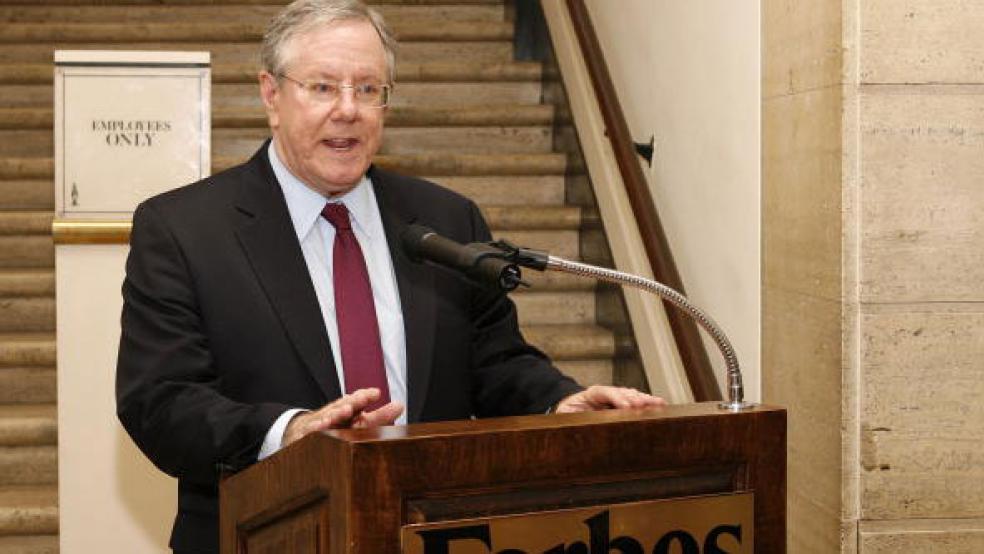“There has not been one instance in history where active monetary management has advanced an economy.” So goes the bold claim in the new book by Steve Forbes and Elizabeth Ames, Money: How the Destruction of the Dollar Threatens the Global Economy – and What We Can Do About It. Forbes aptly critiques central-banking decisions over the last 100 years, and is not afraid to offer his own solutions.
The book begins with a thorough description of how Federal Reserve policy brought the U.S. economy down to where it is today, a feeble economy still in a slow recovery from the Great Recession. The housing bubble’s roots began in the early 2000s, when low rates made it too easy to get loans. People bought homes assuming the value would rise in perpetuity. Then, when the Fed raised interest rates, the bubble popped.
Related: What Happens When the Fed Stops Supporting Stocks?
The Fed’s solution for economic recovery began in November 2008 with the first round of quantitative easing. Forbes describes QE as a colossal mistake. Five and a half years after the start of QE, real GDP has grown at an average rate of only 1.8 percent annually. Between the early 2000s recession and the Great Recession, real GDP growth was an average of 2.8 percent per year. Millions of discouraged Americans have left the labor force, and the percentage of people either employed or looking for work has declined to 1978 levels and remained there.
QE failed largely because of the little-known “Operation Twist,” which sent loans from the monetary expansion to large corporations and the government — a form of cronyism.
The authors compare poor monetary policy to carbon monoxide: “odorless and colorless. Most people don’t realize the damage it’s doing until it’s very nearly too late.” When the housing bubble burst, people knew it was because loans were too cheap, but they did not think to blame cheap loans on the Fed’s weak-dollar policies.
Easy-money policies go unnoticed until people realize how much prices have increased over time. The dollar’s purchasing power has declined by over 80 percent since 1971. Even more recently, the dollar’s value has fallen by 26 percent since 2000. Why such a large drop in only 15 years? QE was “the largest monetary expansion ever [emphasis in original].”
Related: Most Americans Still Have No Idea What QE3 Is
If the public thought of inflation as a tax, instead of just higher prices, FOMC decisions would receive much more scrutiny from both the public and elected officials. Similar to taxes, inflation makes it harder to make ends meet and reduces the amount of money households have available to spend. Inflation shrinks the value of every dollar, so any given dollar can no longer buy as much as it used to. Even John Maynard Keynes, famous for his support of economic stimulus measures, acknowledged inflation as an indirect tax.
The parallels between inflation and taxation do not end at their effect on personal budgets. Economists know how important the price system is to the economy because of the signals a price sends about supply and demand. Inflation and taxation both tarnish the information sent by price signals. Higher prices caused by inflation are often mistaken for increased demand, leading to misinformed decisions that harm economic growth.
The problem is not only with the Fed’s rates, but with the people making the decisions. Even the most-educated economists — and the Fed has plenty — cannot be expected to correctly make the important decisions that affect the endlessly complex economy.
Related: The Threat That Could Scar the Economy for Decades
Rather than putting so much power in the hands of a few people, politics should be taken out of the money supply. Forbes recommends a bold, effective solution for doing so: the gold standard.
Forbes and Ames defend the gold standard against a slew of myths and misconceptions. For instance, gold is actually quite flexible and responsive to changes in demand for money — it allows the money supply to change in response to demand without devaluation.
One of the most useful parts of the book is the analysis of four different types of gold standards, explaining the pros and cons of each one with the assurance that each possibility is still preferable to today’s system. For example, the gold price system would peg the dollar to a given price of gold and have the Federal Reserve buy or sell bonds to keep gold at the given price. The only problem is the challenging task of deciding which price to peg the dollar to. With any type of gold standard the Federal Reserve would still play a role in economic emergencies, remaining a lender of last resort and handling economic panics.
Related: Janet Yellen’s Interest Rate Dilemma
One useful addition would have been a discussion of the Taylor Rule, which would set nominal interest rates according to a formula affected by inflation, output and GDP. The Taylor Rule has recently grown in popularity in light of the FOMC’s controversial decisions to keep interest rates low over five years into economic recovery.
In the past, America’s adoption of an economic policy has spurred mass adoption across the globe. Although the British had a gold standard before the United States, America’s implementation of the gold standard in the 19th century, and subsequent economic growth, inspired other developed countries to do the same. Forbes calls on the United States to first enact sensible monetary reform and then other nations will follow. Re-adopting the gold standard in America could spur the economic powerhouses of the world to join, creating more stable markets and prosperity across the globe. Let us hope.
Jason Russell is a research associate at Economics21 at the Manhattan Institute for Policy Research.




